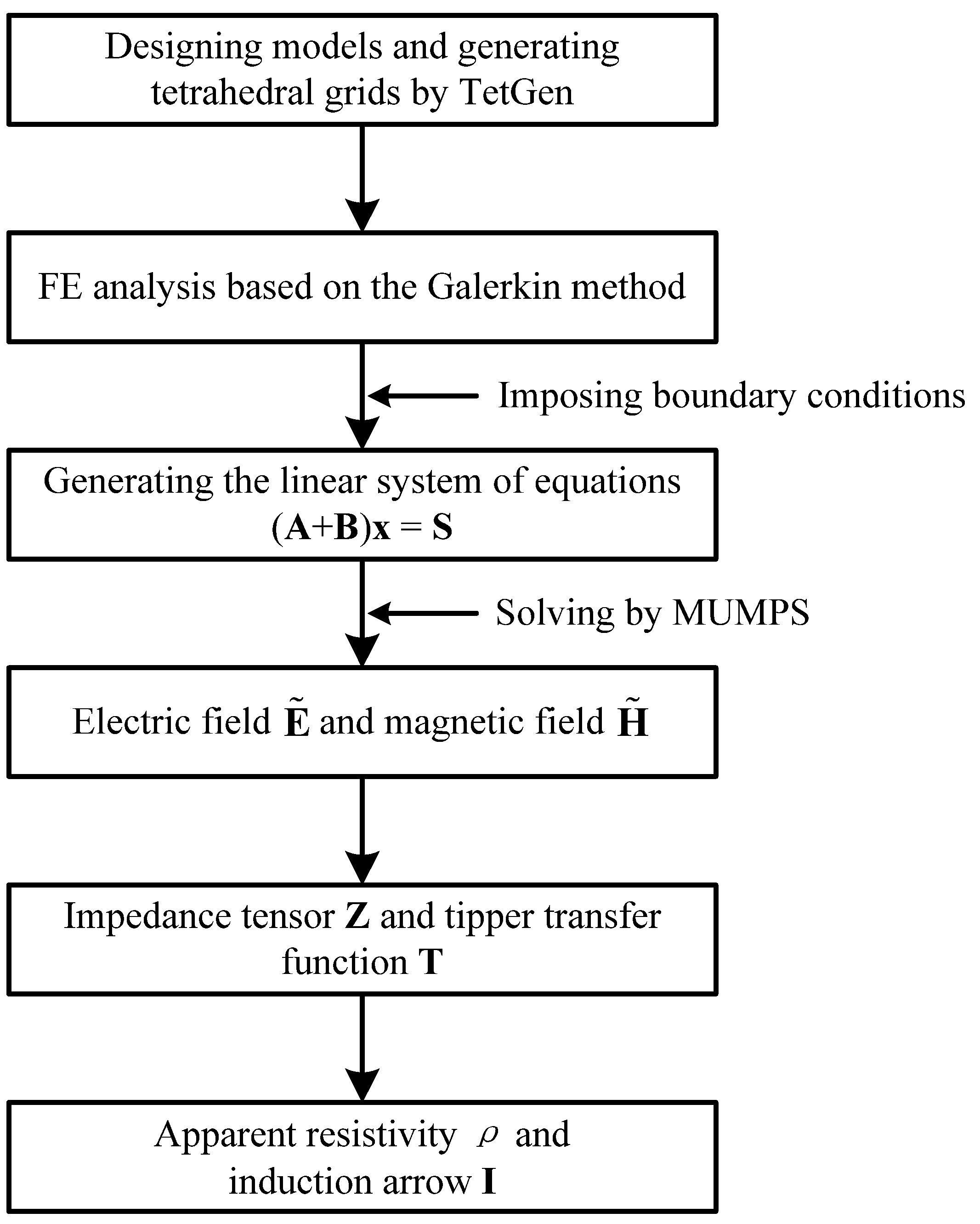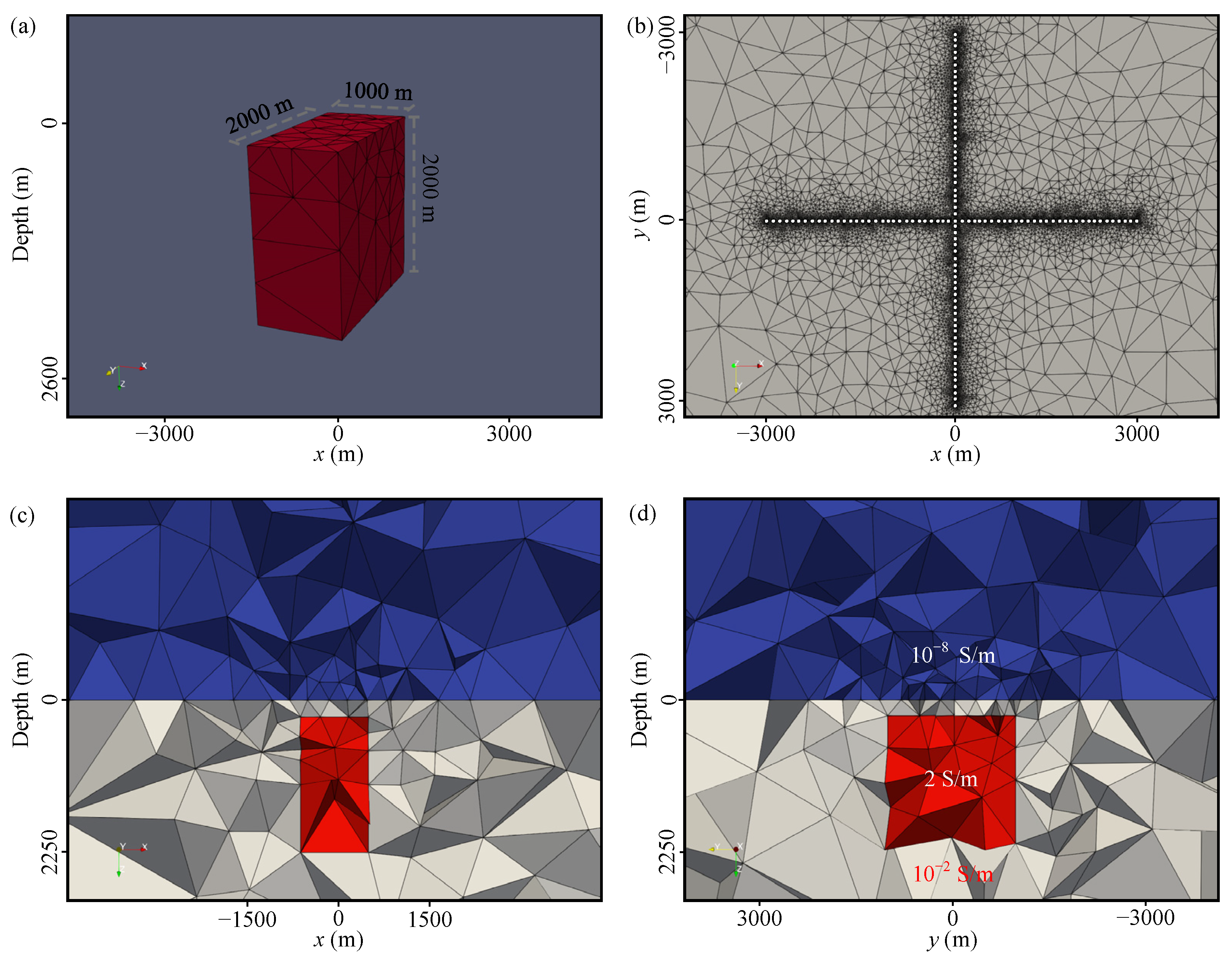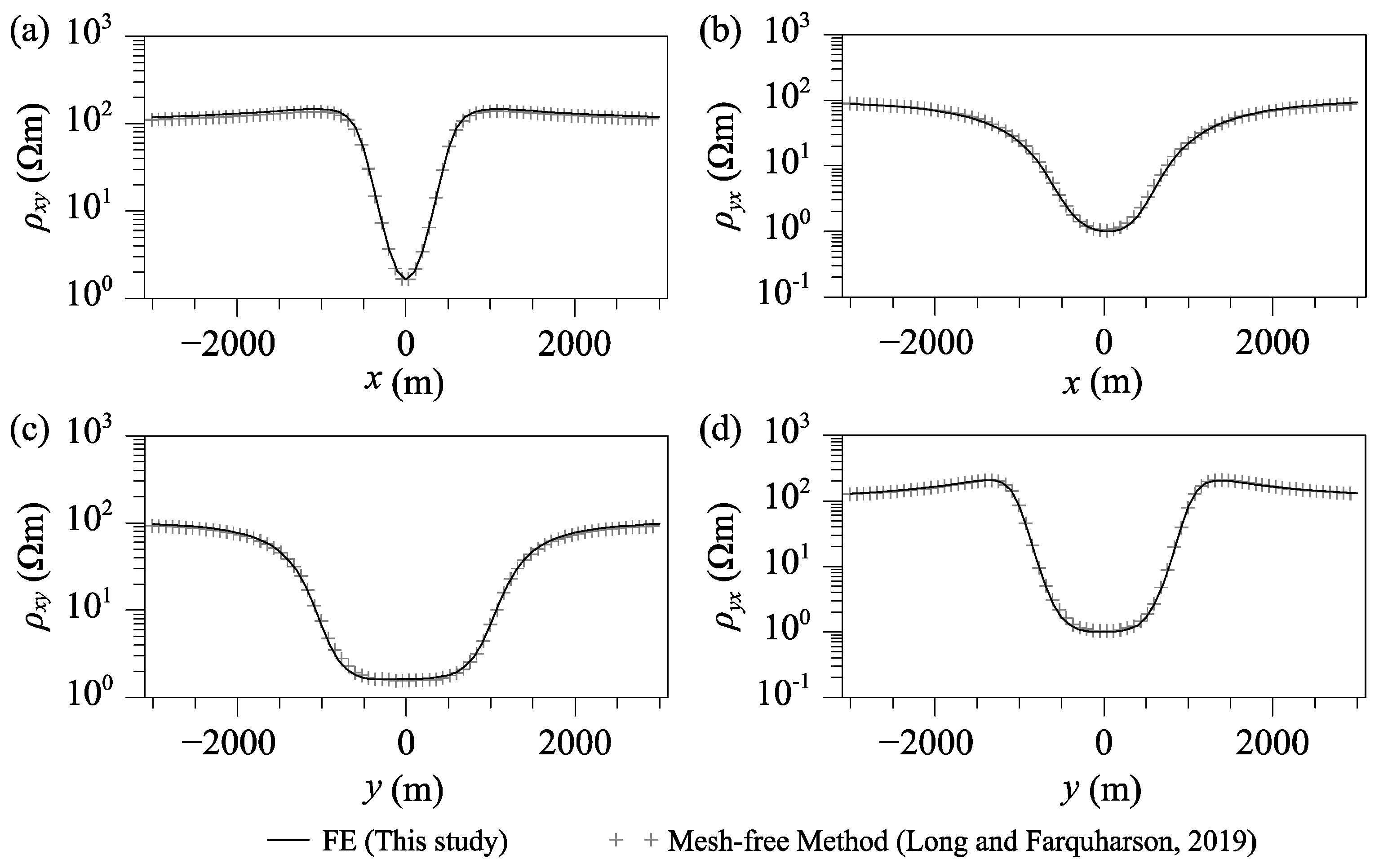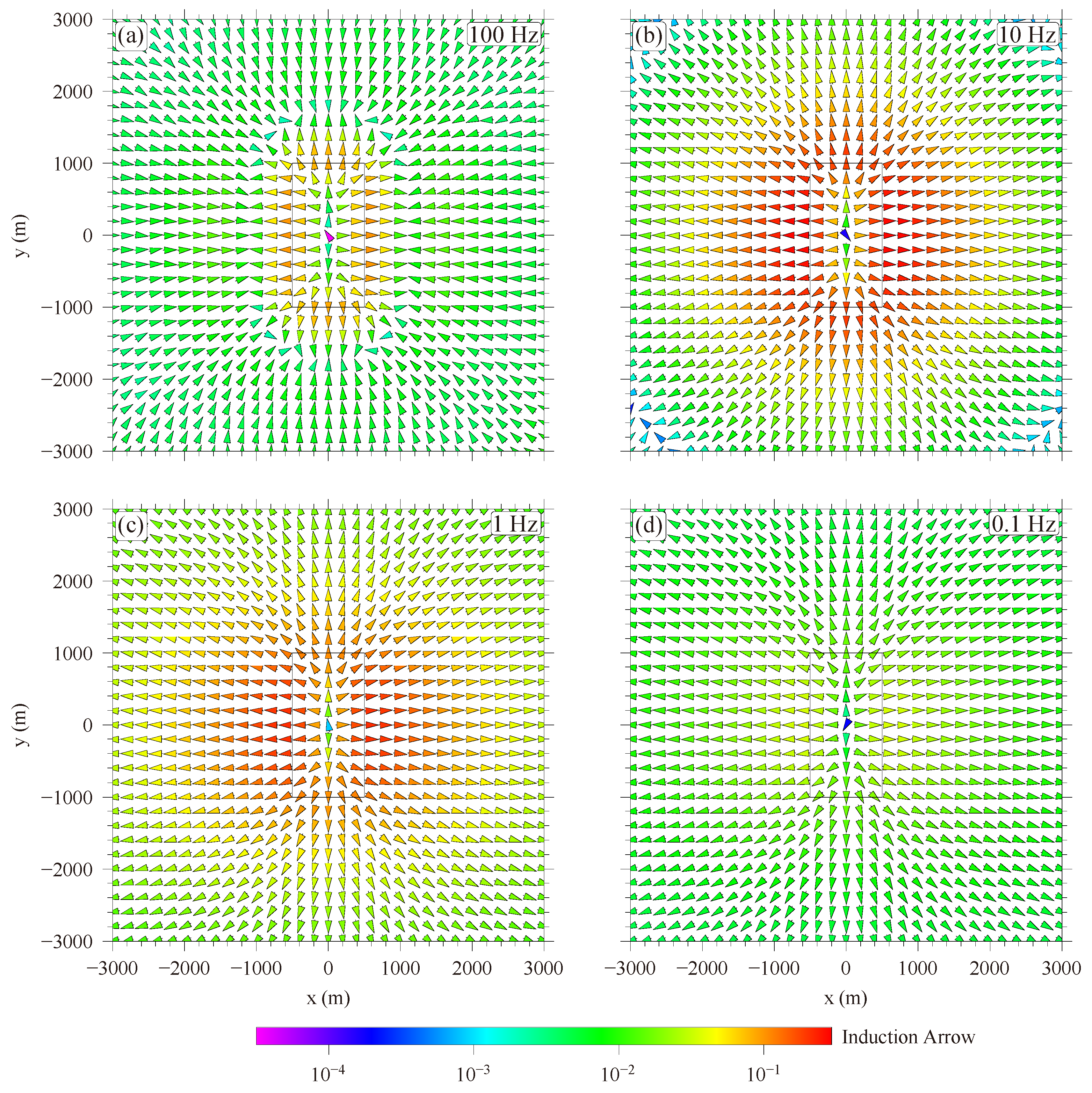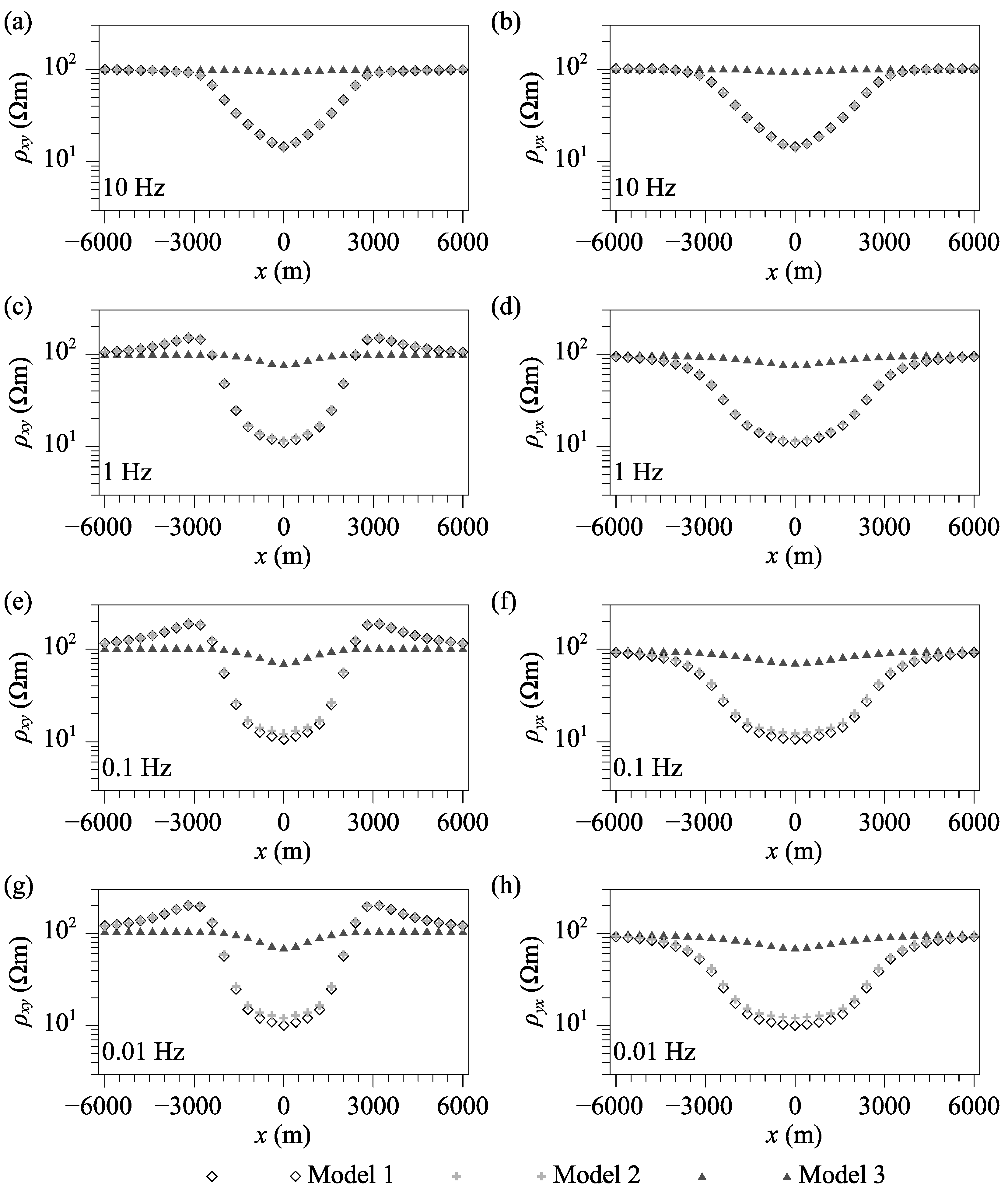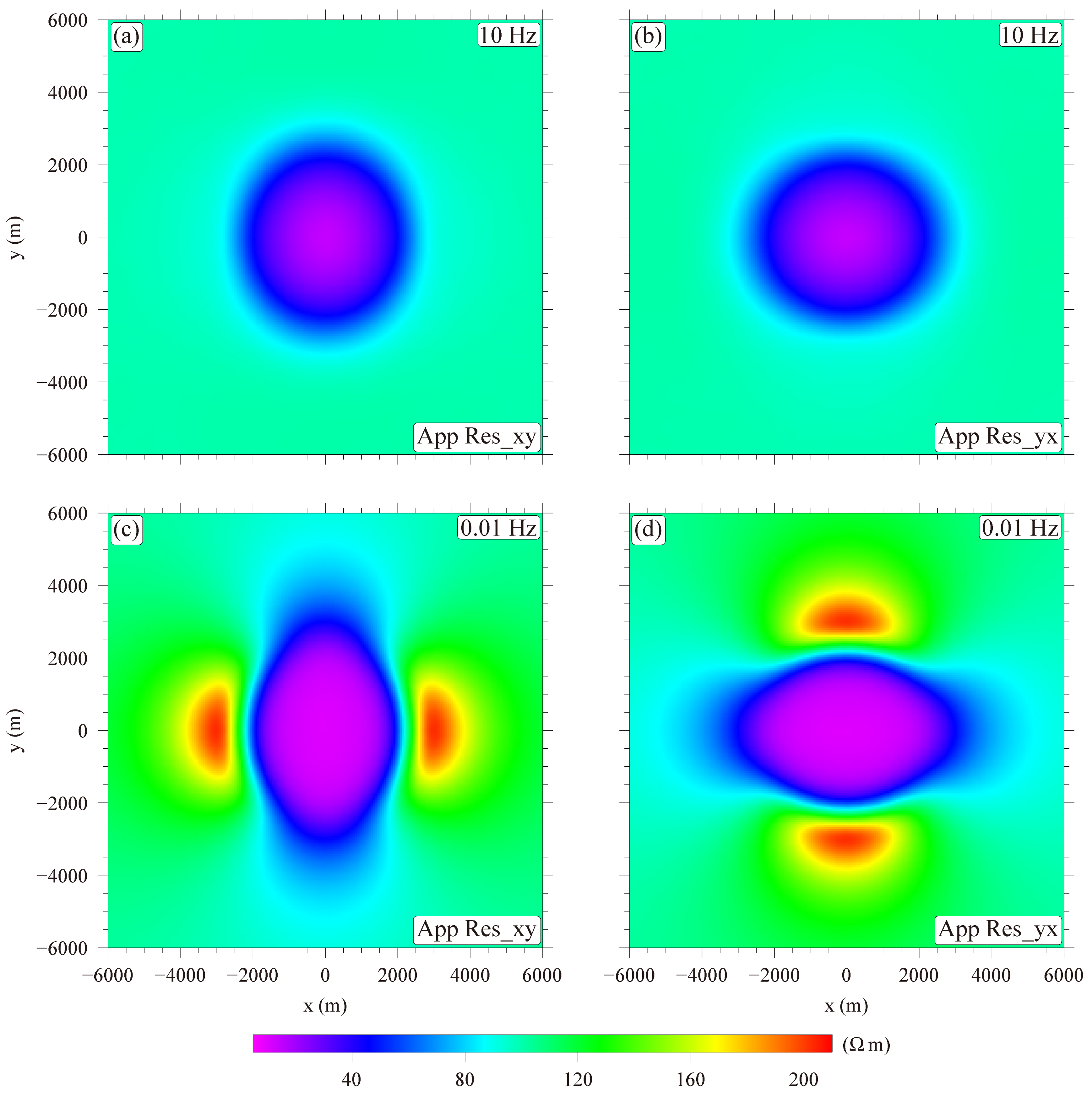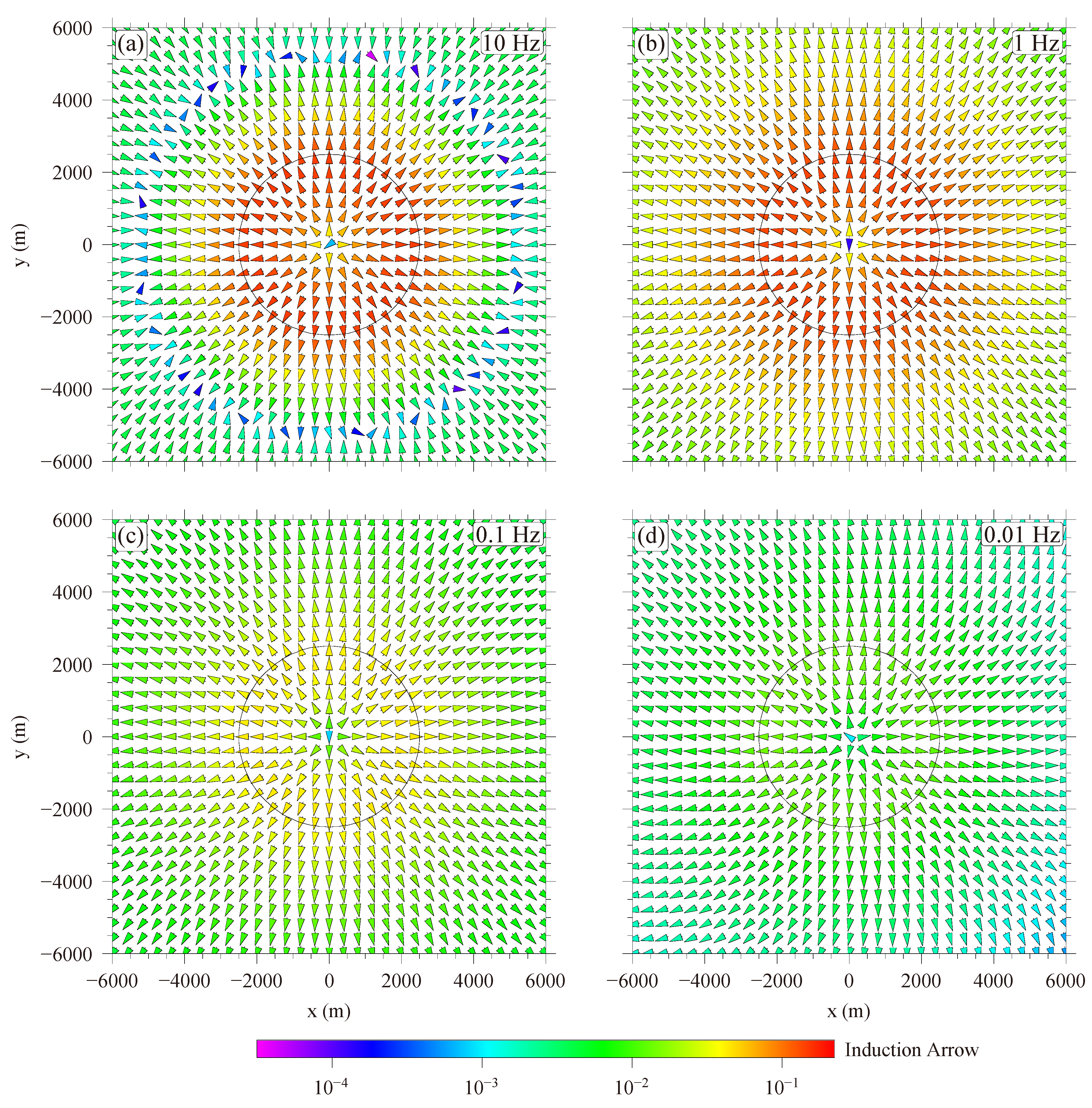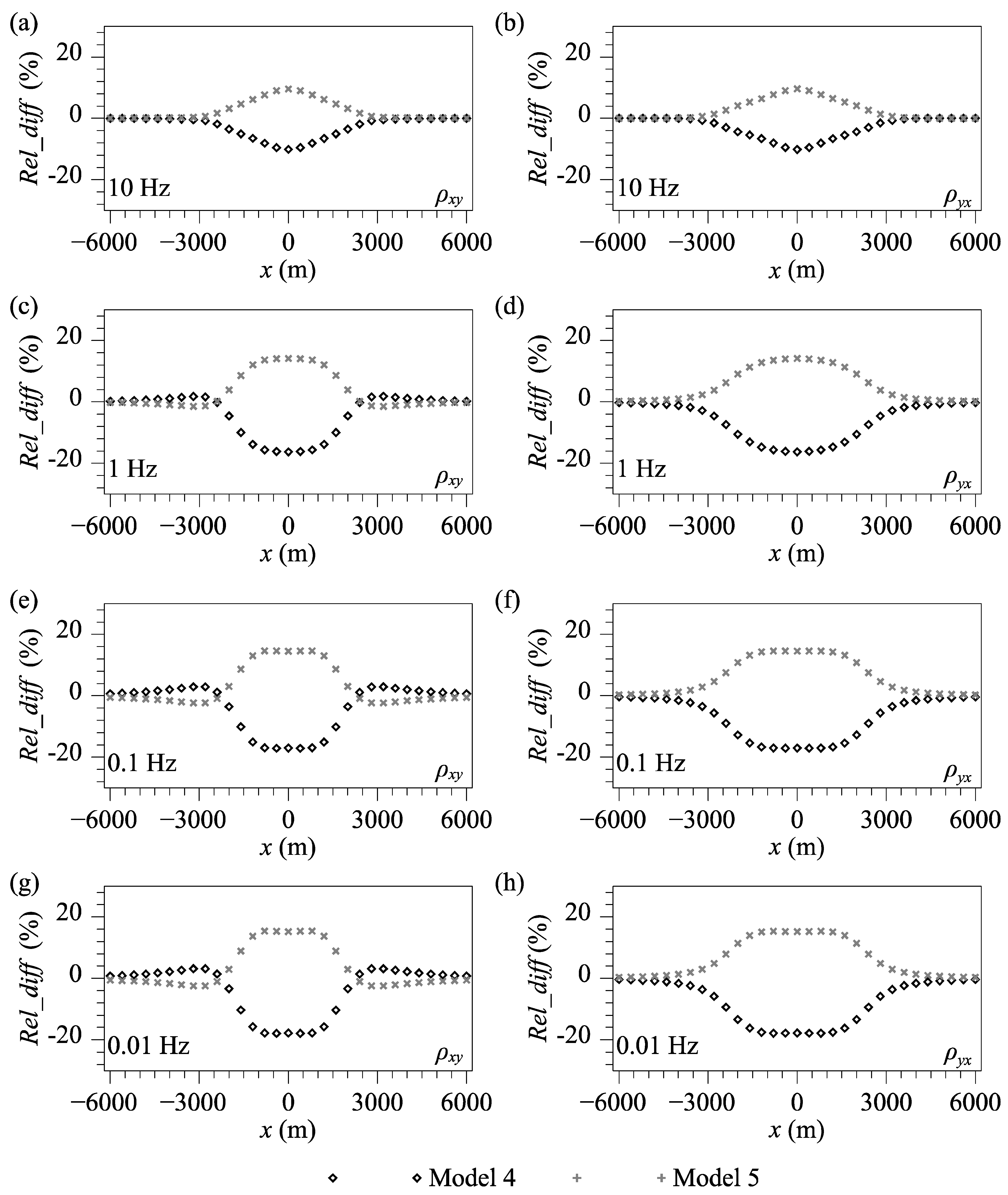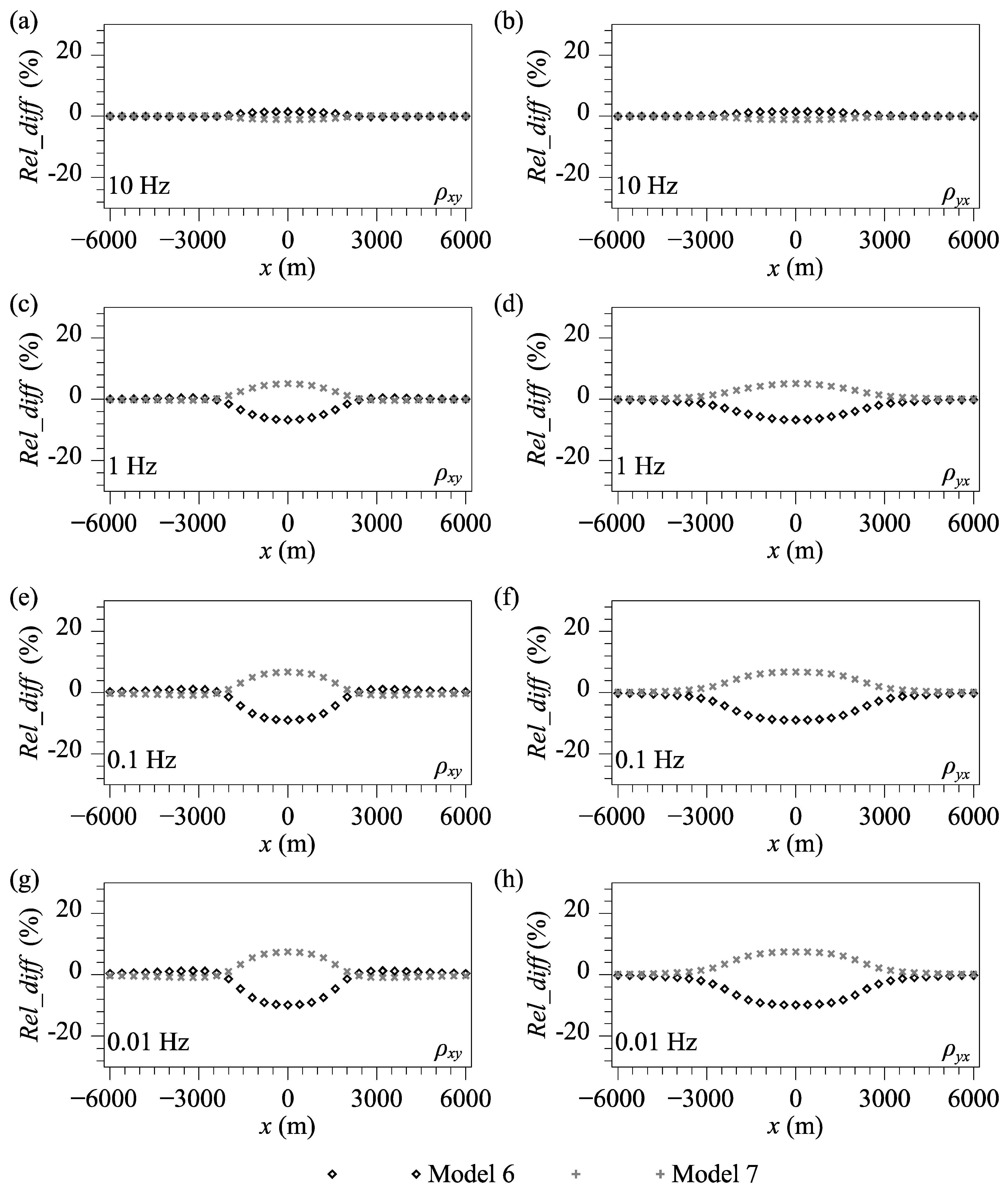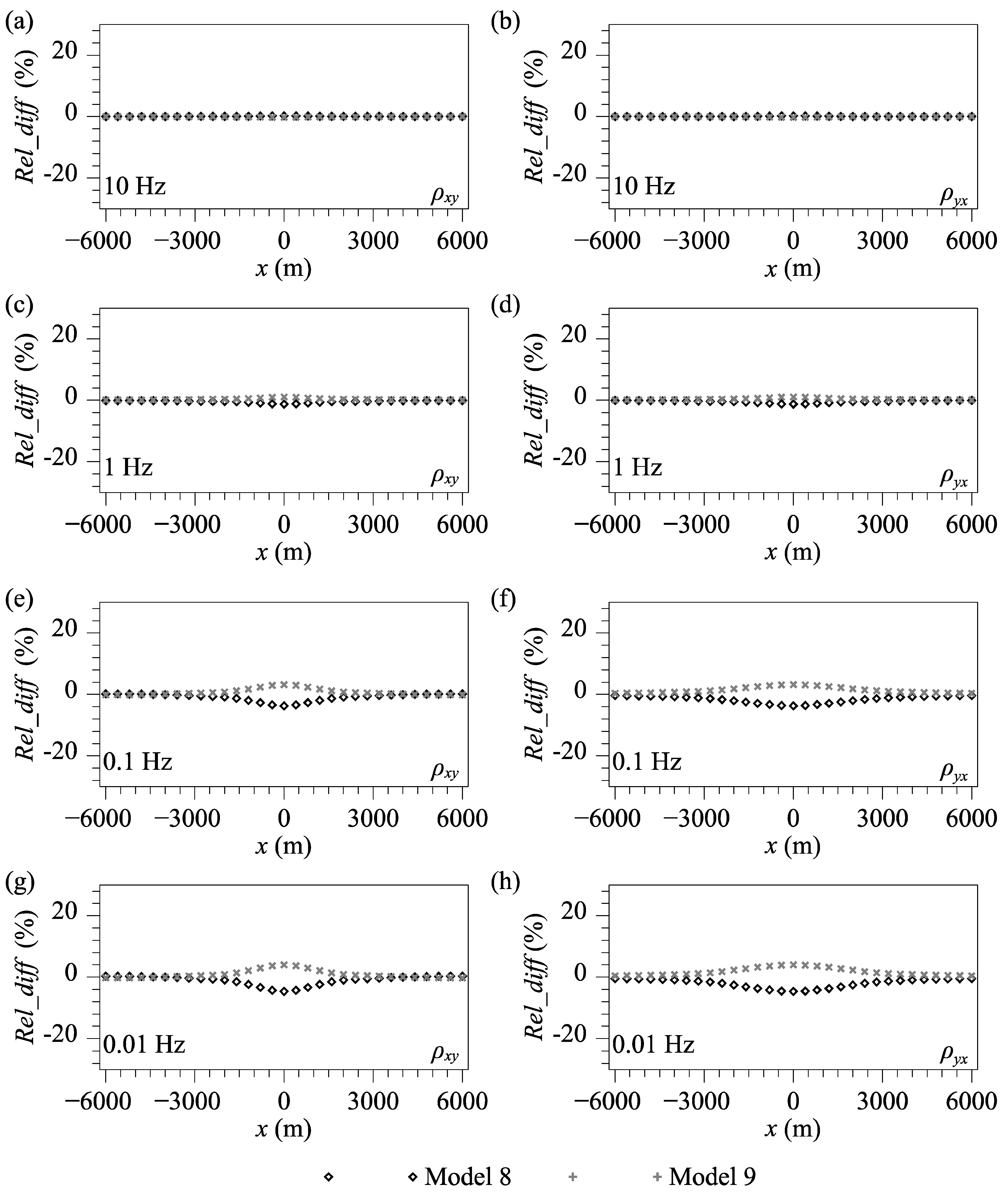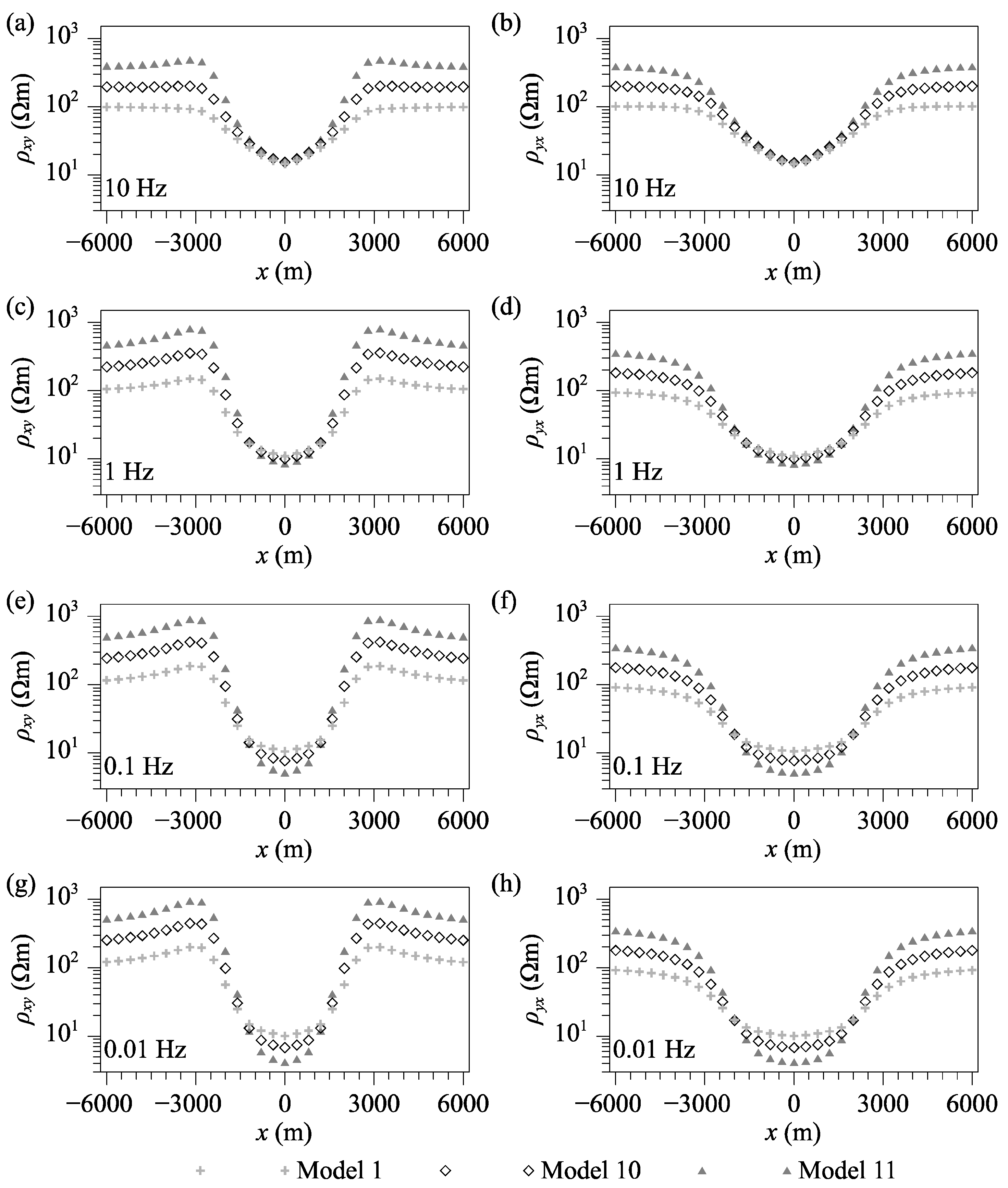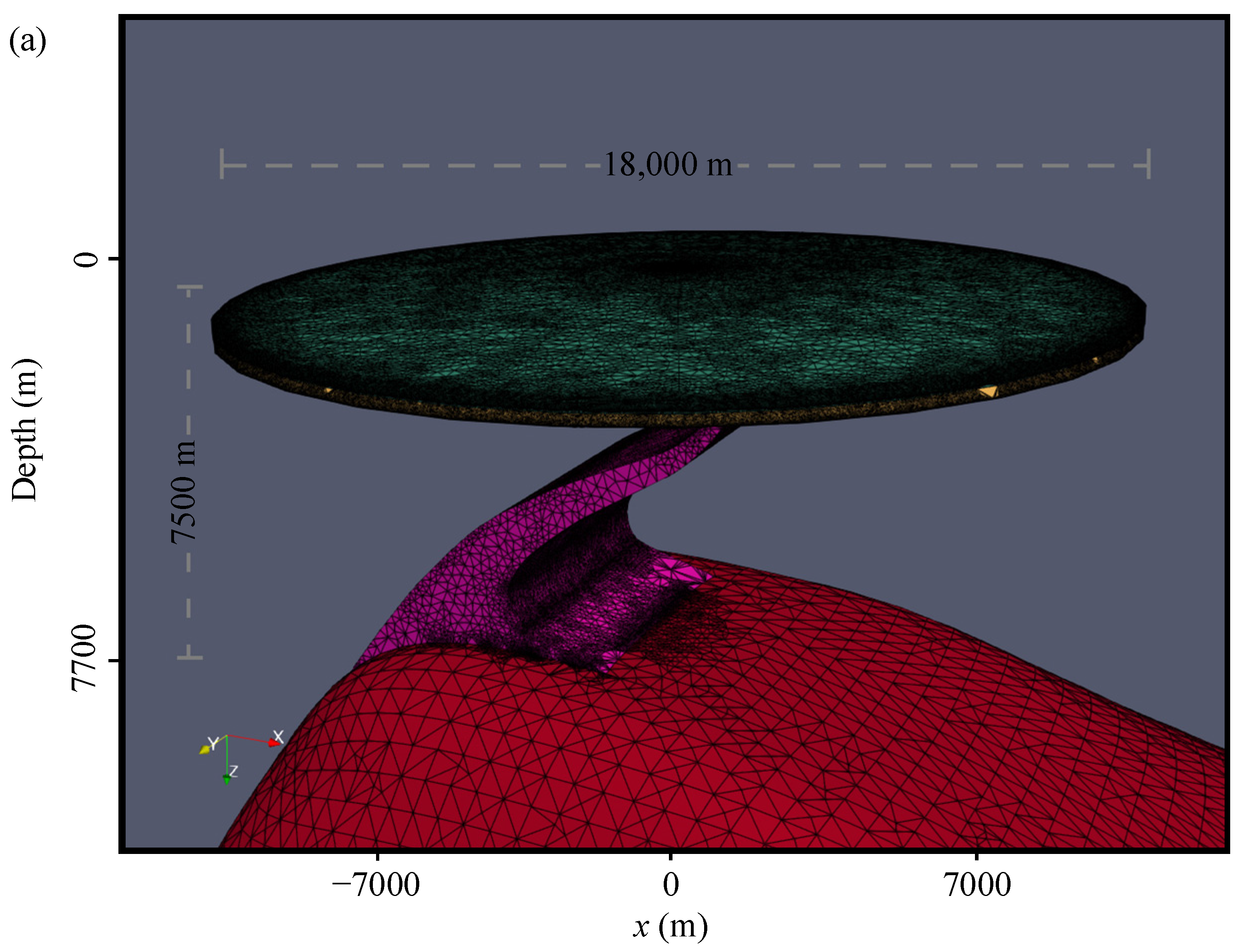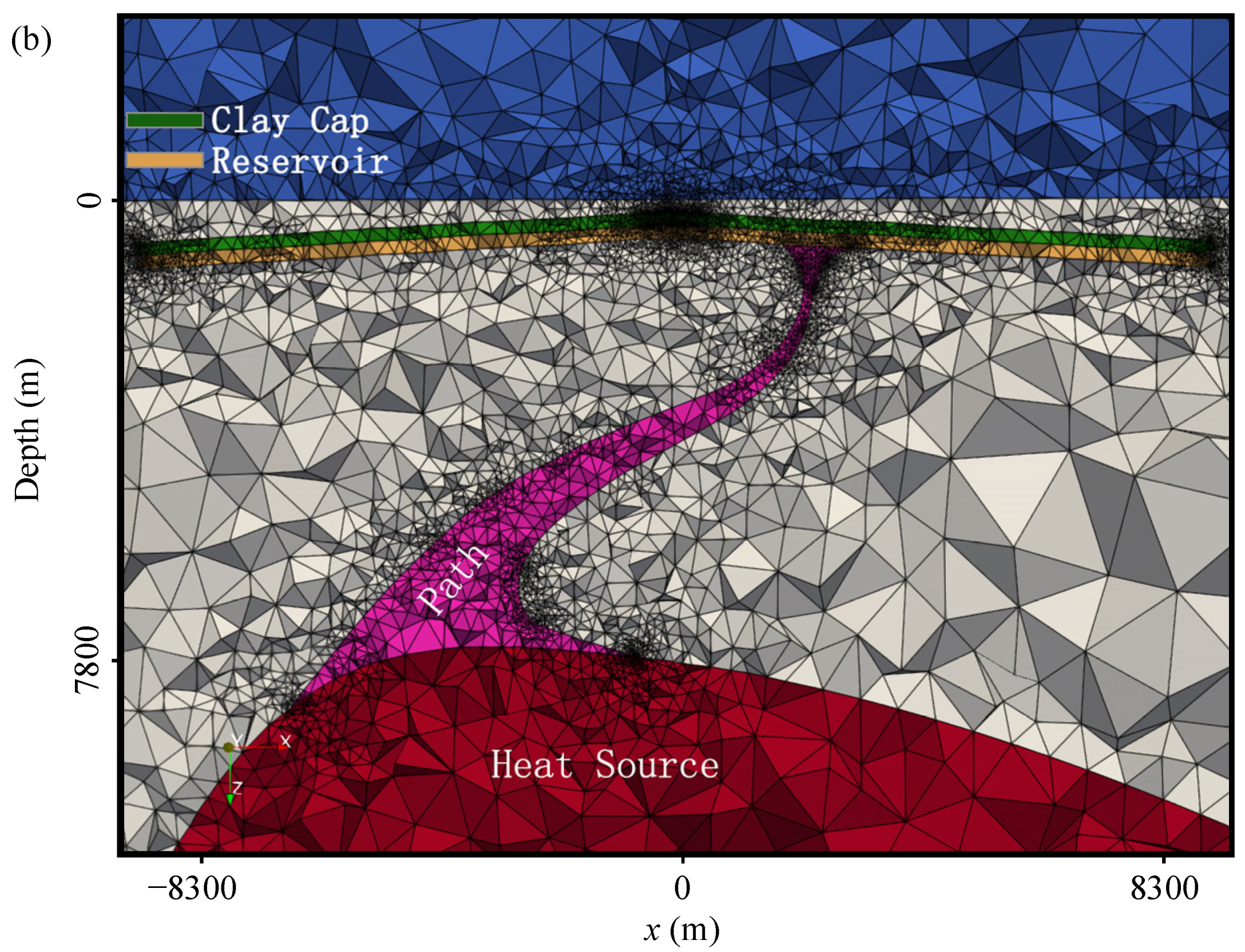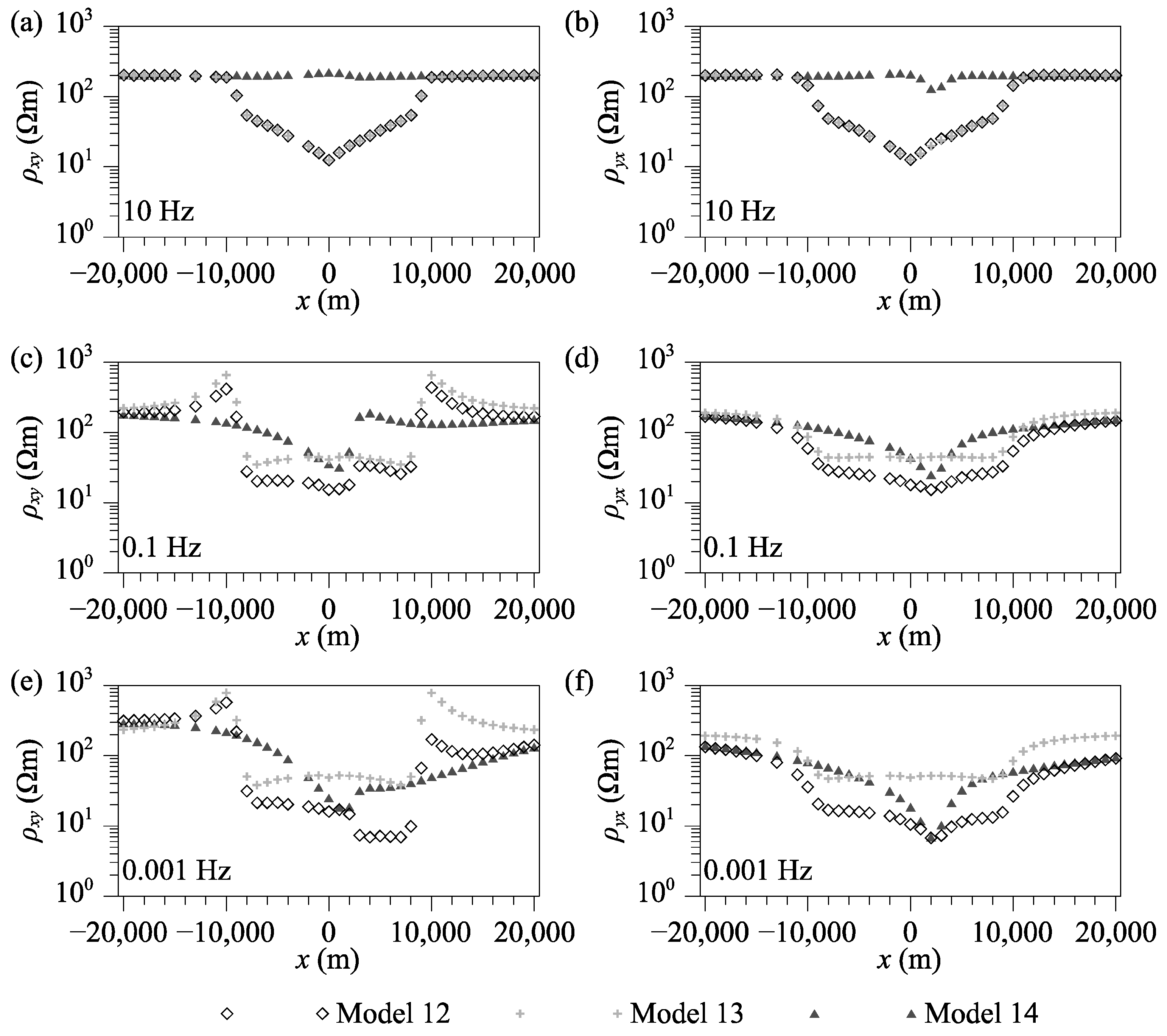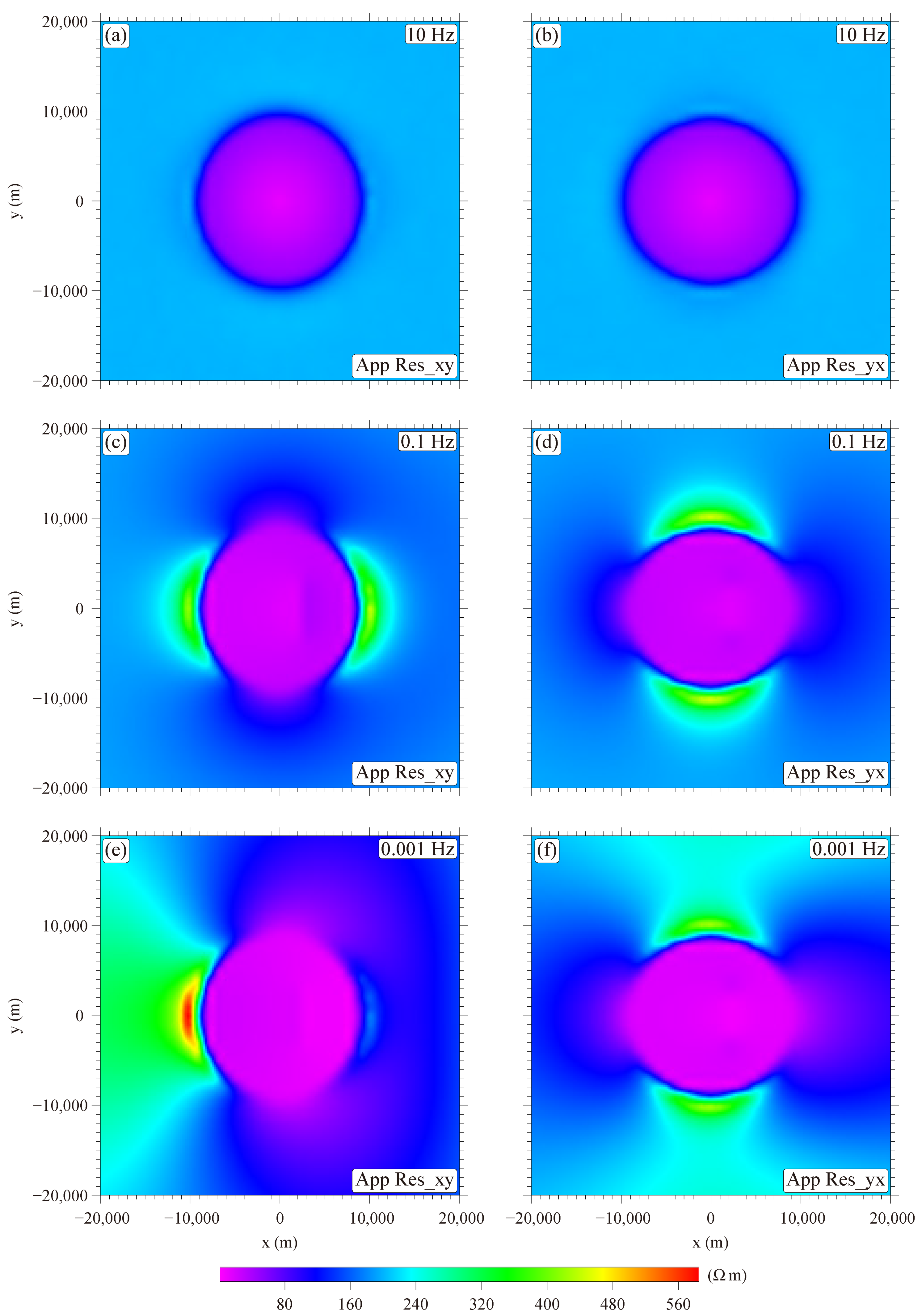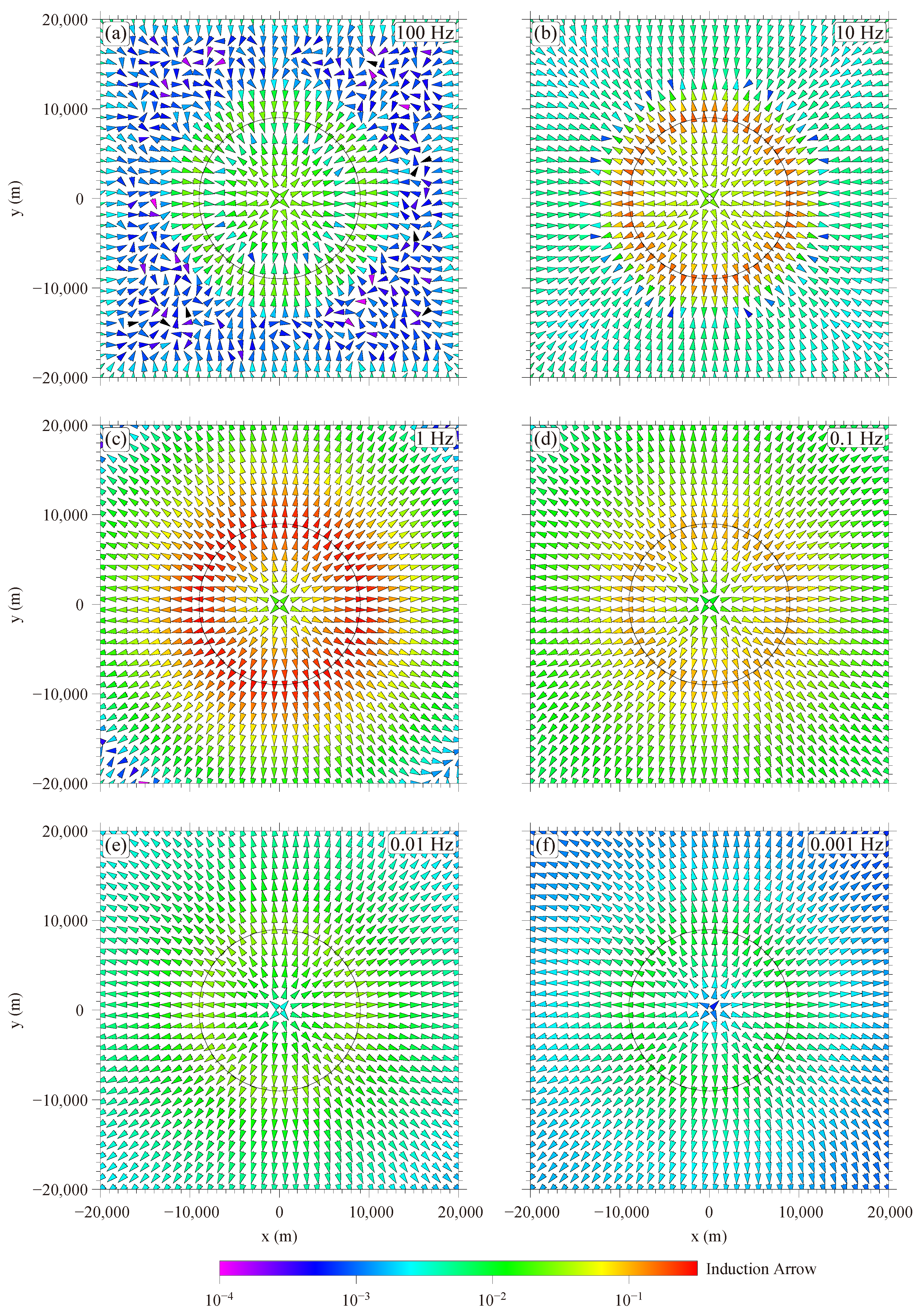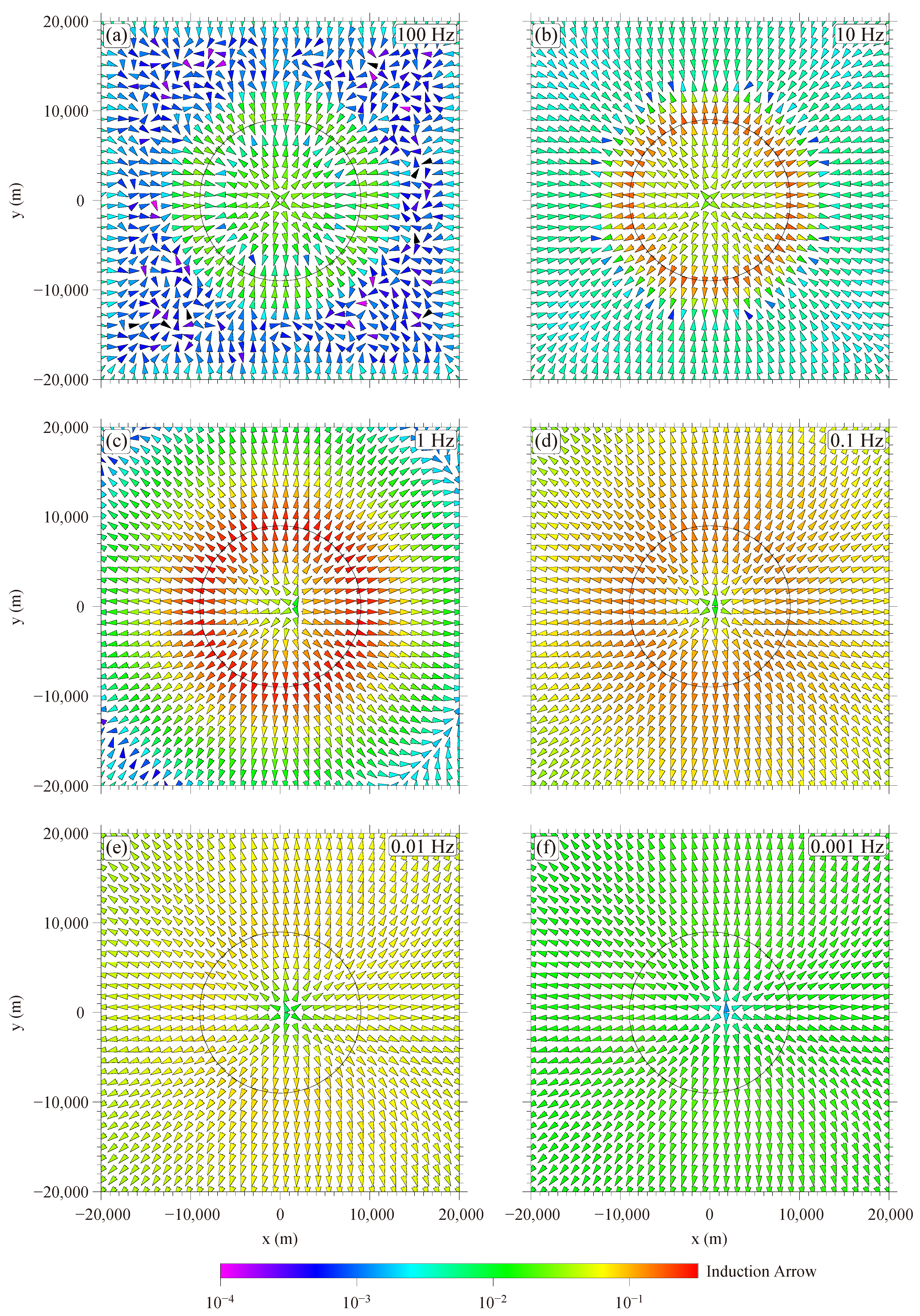In this section, we will first test the FE method developed by ourselves, and then employ it to investigate the characteristics of apparent resistivity and induction arrows for models representing a typical hydrothermal system and an HDR and partial melting system.
3.1. FE Method Testing
The 3D FE forward modeling solver is tested by numerical solutions of the mesh-free method of Long and Farquharson [
23]. The mesh-free method uses only a cloud of unconnected points to obtain numerical solutions throughout a computational domain, it is also termed a radial-basis-function-based finite difference. The geoelectric model used in the test is the COMMEMI 3D-1A model, which is first reported by Zhdanov et al. [
26]. For this model, a conductive block is embedded in a half-space. The resistivities are 0.5 and 100 Ωm for the block and half-space, respectively. The block is 1 × 2 × 2 km
3 in the
x-,
y-, and
z-directions (
Figure 2a). There are two survey lines arranged along the
x- and
y-directions. Each line has 61 stations with 100 m intervals (
Figure 2b). The computational domain is set to 100 × 100 × 100 km
3. The central domain of the tetrahedral mesh generated by TetGen 1.5.1 [
27] is shown in
Figure 2c,d.
Figure 3 shows the apparent resistivity curves for the COMMEMI 3D-1A model. Here the frequency is set to 0.1 Hz. As shown in
Figure 3, the curves for both
ρxy and
ρyx calculated by the FE and the mesh-free methods are in good agreement with each other. The apparent resistivity data calculated by the FE method are shown in
Table 1.
Figure 4 shows the induction arrow for the COMMEMI 3D-1A model, and the corresponding data are shown in
Table 2. For the induction arrows, their direction is away from the conductive block, and the maximum values of their length always occur in the outer domain around the conductive block for all frequencies (
Figure 4). The length of the induction arrows increases as the frequency decreases from 100 Hz to 10 Hz, and then decreases as the frequency decreases.
3.2. Hydrothermal System
A series of synthesized models for a typical hydrothermal system are investigated first. As shown in
Figure 5, a hydrothermal system buried in a half-space is comprised of three parts, namely a smectite layer, an illite-smectite mixed layer, and a reservoir. The reservoir is underneath the two clay layers. The thickness was set to 320 m for both clay layers, and the lengths both in the
x- and
y-directions were set to 5000 m. The reservoir has a bullet shape, and its maximum height is 5300 m. It should be noted that we did not consider a heat source in these models. There were 41 observation lines were designed on the surface, and each line has 41 stations. Both station and line spacing are 400 m. Due to their complicated shape, these models are designed by 3ds Max, which is a professional software used for building 3D models. A designed model in 3D Studio Max is exported as an obj-format file and then is transformed into piecewise-linear-complex files that can be provided to TetGen to generate unstructured tetrahedral meshes [
28]. In order to ensure a high modeling accuracy, the tetrahedral grids around observation stations need to be refined. For these models, the computational domain is discretized into 14,015,861 tetrahedra. The resistivity value for each body is listed in
Table 3.
In order to separately study the characteristics of MT apparent resistivity induced by every part of the geothermal system, we set the reservoir resistivity to the half-space resistivity in Model 2 and set the resistivities of the smectite layer and illite-smectite mixed layer (clay cap) to that of the half-space resistivity in Model 3.
Figure 6 shows the apparent resistivity curves for Models 1, 2, and 3, and the corresponding data for Model 1 are shown in
Table 4. Both the
ρxy and
ρyx curves of Models 1 and 2 are in good agreement with each other for the frequencies of 10 and 1 Hz and then diverge from
x = −1500 m to
x = 1500 m as the frequency decreases. The
ρxy and
ρyx values for Model 3 are nearly the same as the half-space resistivity at all observation stations for the frequency of 10 Hz, and then gradually bends down from
x = −1500 m to
x = 1500 m as the frequency decreases. The minimum value of the
ρxy curve is about 70 Ωm for Model 3 and is far larger than the corresponding ones for Models 2 and 3. It illustrates that the total EM responses for this hydrothermal system are dominated by the ones induced by the shallow, low-resistivity clay cap as the frequency decreases from 10 Hz to 0.01 Hz.
Figure 7 shows the contour map of
ρxy and
ρyx at 10 and 0.01 Hz for Model 1. The low apparent resistivities only occur in the central domain of these four contour maps (see
Figure 7). As stated above, the EM responses associated with the shallow, low-resistivity clay cap are dominant in the total EM responses. Consequently, the low apparent resistivities associated with these domains are primarily caused by the clay cap, and secondarily by the reservoir.
Figure 8 shows the vector maps of induction arrows for Model 1, and the corresponding data are shown in
Table 5. The direction of the induction arrows points outwards away from the central domain. The maximum values of their length at 10 and 1 Hz always concentrate in the inner and outer domains close to the circles marking the projections of the smectite-layer boundary on the surface. They mainly occur in the inner domain of the circles at 0.1 Hz. It illustrates that the induction arrows could reflect the hydrothermal system well.
Then, we investigate the apparent resistivity characteristics as the resistivity of every part of the geothermal system is perturbed. The perturbing value is 20% of the resistivity of each part in Model 1. For example, the smectite-layer resistivity is 5 Ωm in Model 1, and it changes to 4 and 6 Ωm in Models 4 and 5, respectively.
Figure 9,
Figure 10 and
Figure 11 show the apparent resistivity curves when the resistivities of the smectite layer, illite-smectite mixed layer, and reservoir being perturbed in turn. In these three figures, the relative difference between the apparent resistivities of Model 1 and a given perturbed model is calculated by the following formula:
where
and
denote the apparent resistivities for Model 1 and the perturbed models at a given frequency
f, respectively.
As shown in
Figure 9, the absolute values of relative differences of
ρxy and
ρyx increase as the frequency decreases, and they are nearly identical for the frequencies of 0.1 and 0.01 Hz. This phenomenon also occurs in
Figure 10 and
Figure 11. In these two figures, the two relative difference curves are nearly coincident with each other for the frequency of 10 Hz, especially in
Figure 11, and then gradually diverge. The maximum relative differences are about 16% in
Figure 9g,h, and decrease to 8% in
Figure 10g,h, and to 4% in
Figure 11g,h. The above phenomena illustrate that the shallow conductive smectite layer and illite-smectite mixed layer have remarkable shielding effects on the deeper reservoir, and the changes in the reservoir resistivity have less important effects on apparent resistivities.
The effects of half-space resistivities on apparent resistivities are shown in
Figure 12. The apparent-resistivity curves bend down when the
x-coordinate ranges from −3000 m to 3000 m for all frequencies and models. For 10 and 1 Hz, the three apparent-resistivity curves nearly agree with each other between
x = −1500 m and
x = 1500 m and diverge elsewhere (see
Figure 12a–d). For the two lower frequencies, the three apparent-resistivity curves diverge even for the
x coordinate from −1500 m to 1500 m, and the minimum apparent resistivities decrease as the half-space resistivity increases (see
Figure 12e–h). It confirms that a large resistivity contrast between an anomalous body (the hydrothermal system) and its surrounding host makes it easier to detect the anomalous body using the MT method.
3.3. HDR and Partial Melting System
A series of models for an HDR and partial melting system are also investigated. Compared with models for a hydrothermal system, a more conductive heat source associated with a partial melting body is added to the synthesized models for an HDR and partial melting system. As shown in
Figure 13, this geothermal system consists of clay cap, reservoir, path, and heat source. The reservoir and the heat source are connected by the heat-conducting path. For both the clay cap and reservoir the thickness was set to 240 m, and the lengths both in the
x- and
y-directions were set to 18,000 m. The numbers for both observation lines and station are still 41, but the interval is 1000 m. The computational domain is divided into 19,540,394 tetrahedra.
The resistivity values for each part of Model 12 are listed in
Table 6. Here we also set the resistivities of the path and the heat source to 200 Ωm in Model 13 and set the resistivities of the clay cap and reservoir to 200 Ωm in Model 14 in order to study the apparent-resistivity characteristics caused by every part of the geothermal system separately.
Figure 14 shows the apparent resistivity curves for Models 12, 13, and 14, and the corresponding data for Model 12 are shown in
Table 7. The
ρxy and
ρyx curves for Model 13 are always symmetrical at all frequencies due to the symmetrical shapes of the clay cap and reservoir. The
ρxy and
ρyx values for Model 14 seem to be the same as the half-space resistivity at 10 Hz, except for
ρyx at several observation stations, and then decrease to various levels for all observation stations at 0.1 and 0.001 Hz because of the irregular shapes of the path and heat source. Hence both the
ρxy and
ρyx curves of Model 12 match well with the ones of Model 13 at 10 Hz, and then present a complex shape at 0.1 and 0.001 Hz due to the effects of the path and heat source. It indicates that the total EM responses for the HDR and partial melting system are dominated by the responses caused by the shallow low-resistivity clay cap and reservoir at 10 Hz, and are dramatically affected by the path and heat source at lower frequencies, especially at 0.001 Hz.
Figure 15 shows the contour maps of
ρxy and
ρyx at 10, 0.1, and 0.001 Hz for Model 12. The low apparent resistivities mainly occur in the central part of these six contour maps (see
Figure 15). Unlike the symmetrical low-apparent-resistivity domains at 10 Hz, the ones at 0.1 and 0.001 Hz are not symmetrical about the
x-coordinate (see
Figure 15c–f). It demonstrates that the regions with low apparent resistivity are mainly associated with the symmetrically shaped clay cap and reservoir at 10 Hz, as well as associated with all parts of this geothermal system at 0.1 and 0.001 Hz. These characteristics also appear in the vector maps of induction arrows for Model 12 (see
Figure 16 and
Figure 17). As shown in
Figure 16, the vector maps of Model 13 are symmetrical about both the
x- and
y-axes, because of the symmetry of this model.
Figure 17 is the vector map for Model 12, which has an un-symmetrical electrical structure. Compared with these two figures, the vector maps for the frequencies of 0.1, 0.01, and 0.001 Hz are different in the symmetrical pattern and the magnitudes of the vector arrows. It can be inferred that the path and heat source can cause significant EM responses for the HDR and partial melting system at these three lower fre-quencies. The corresponding data of
Figure 17 are shown in
Table 8.
